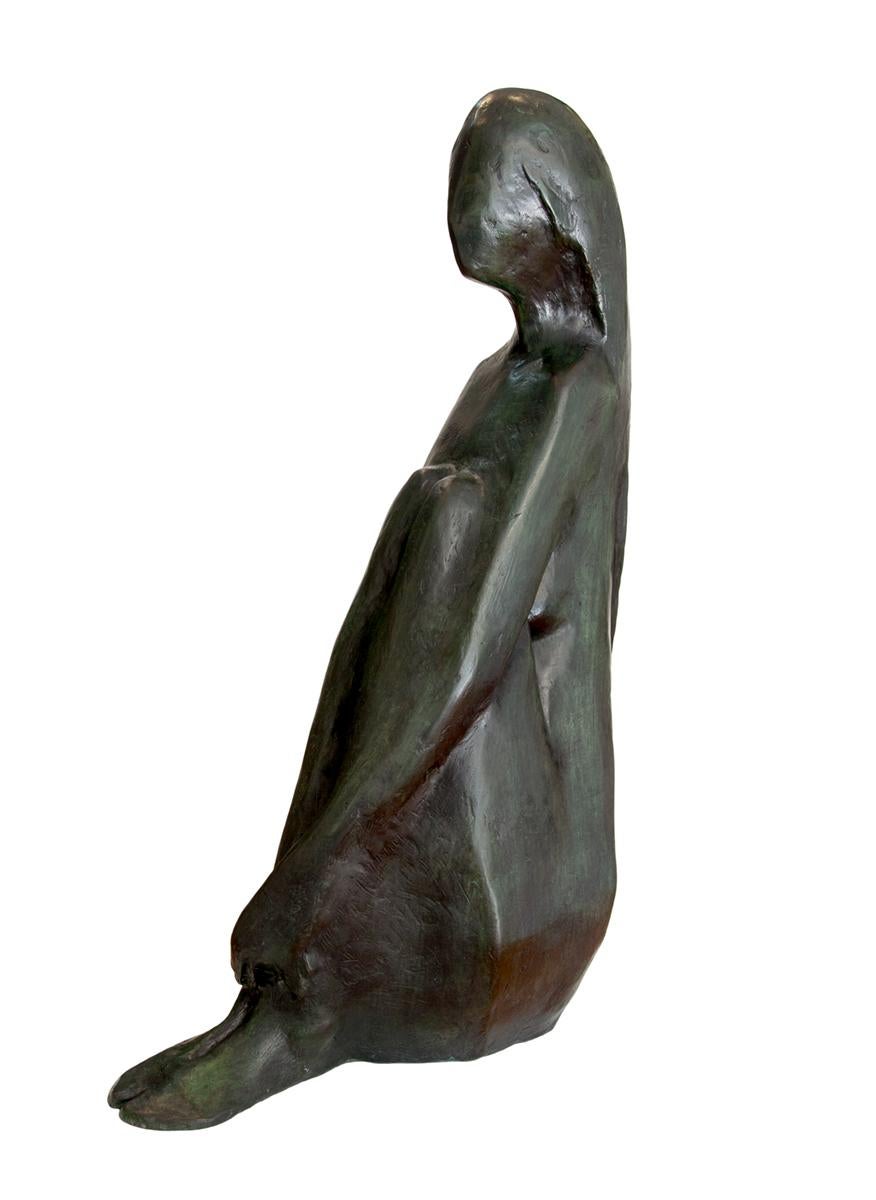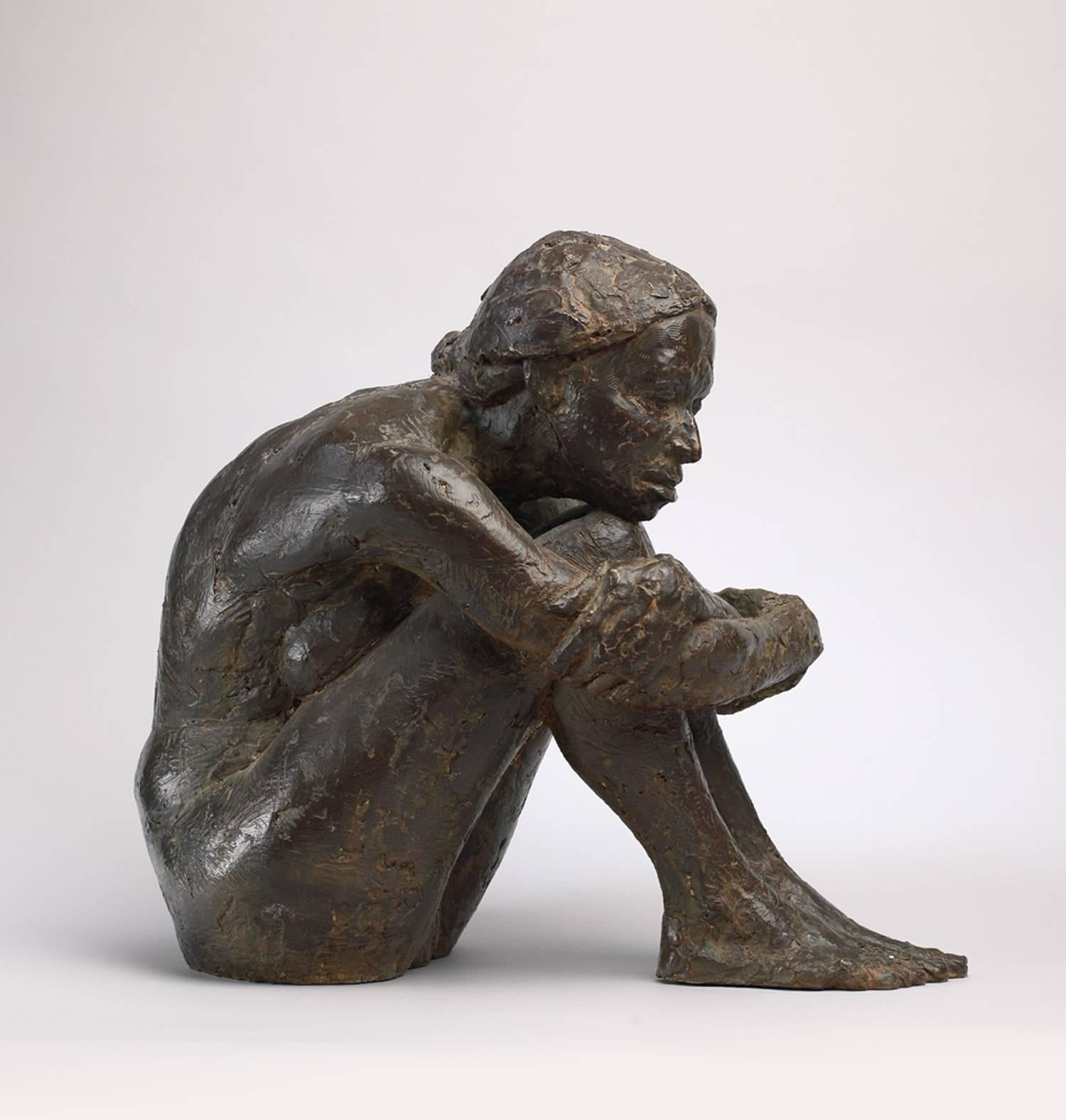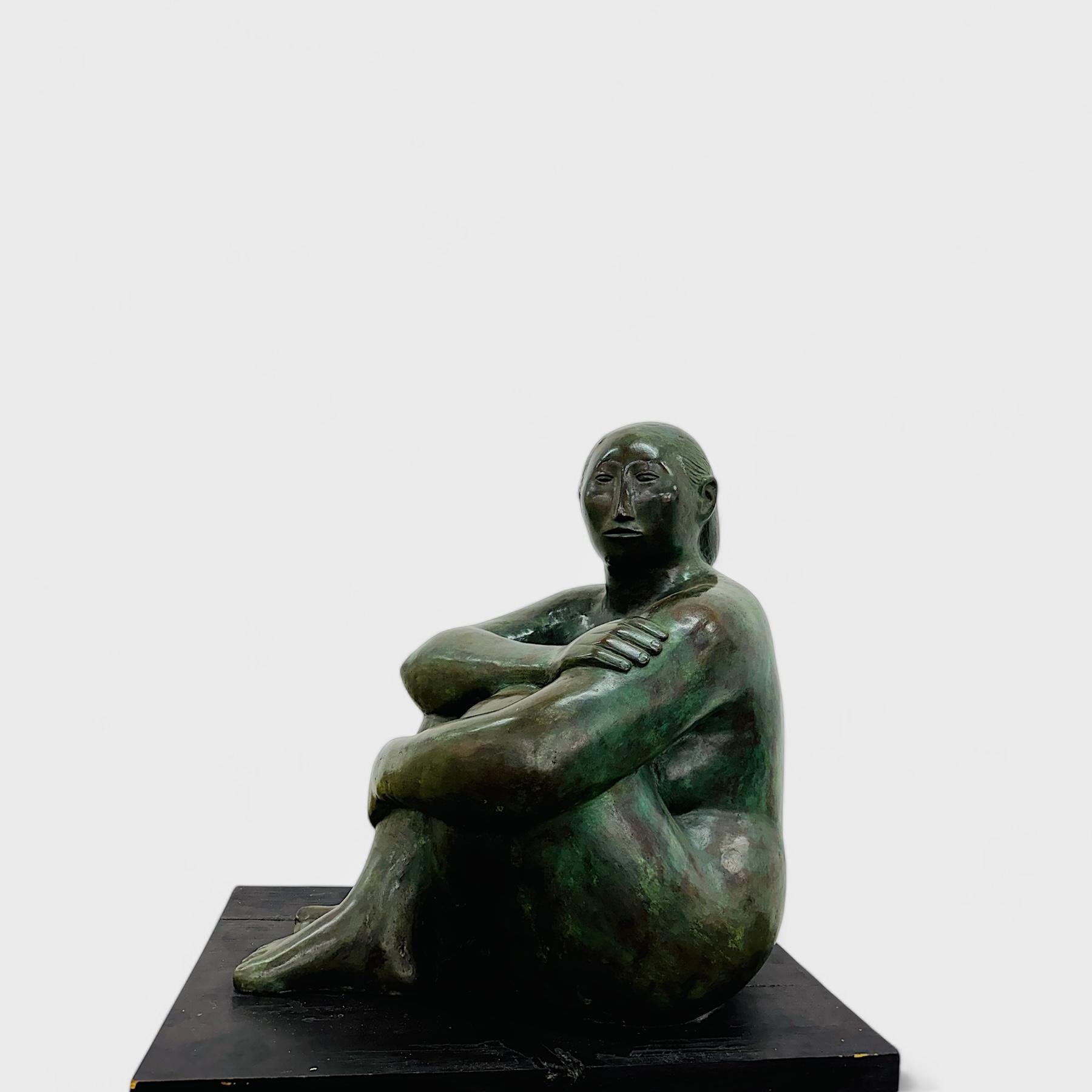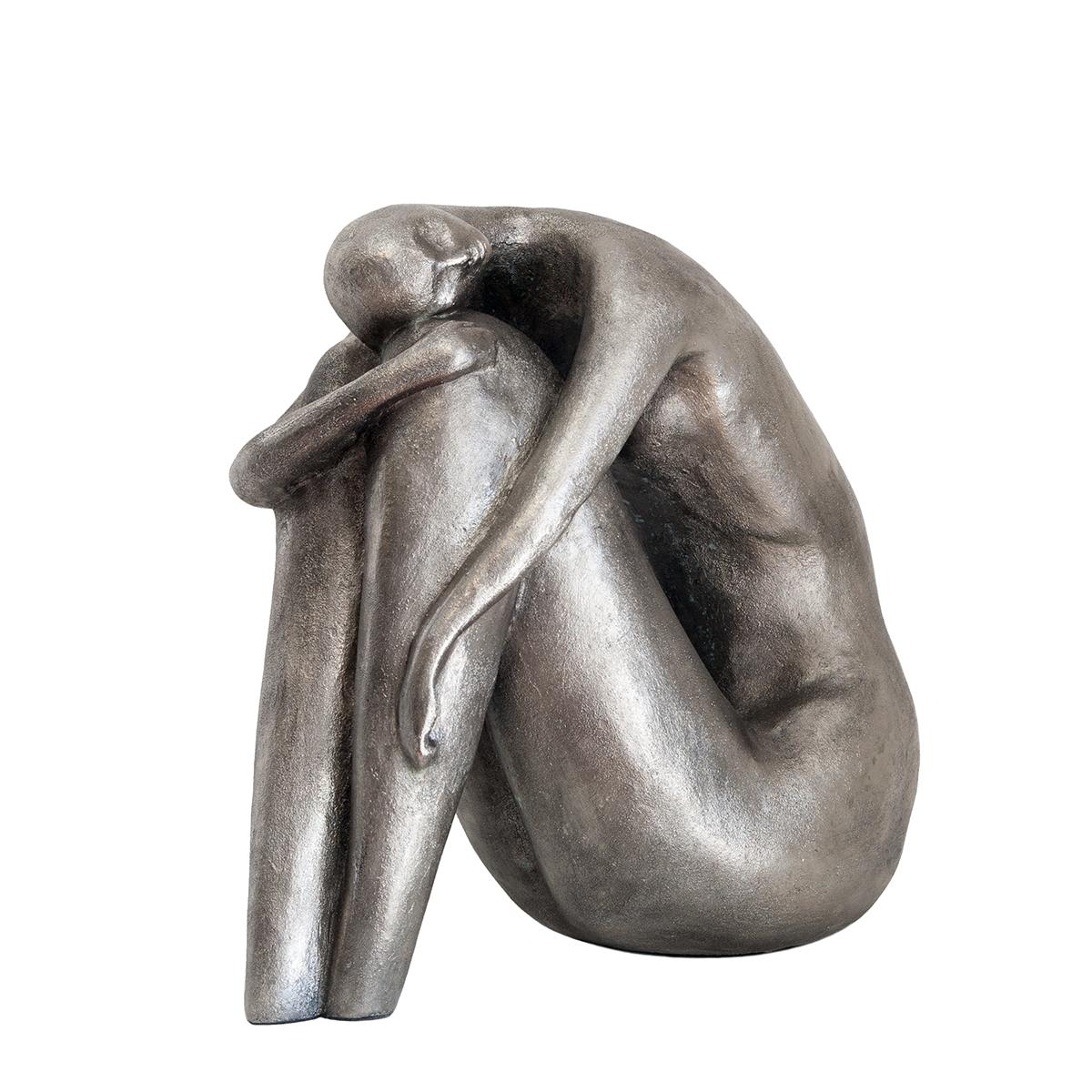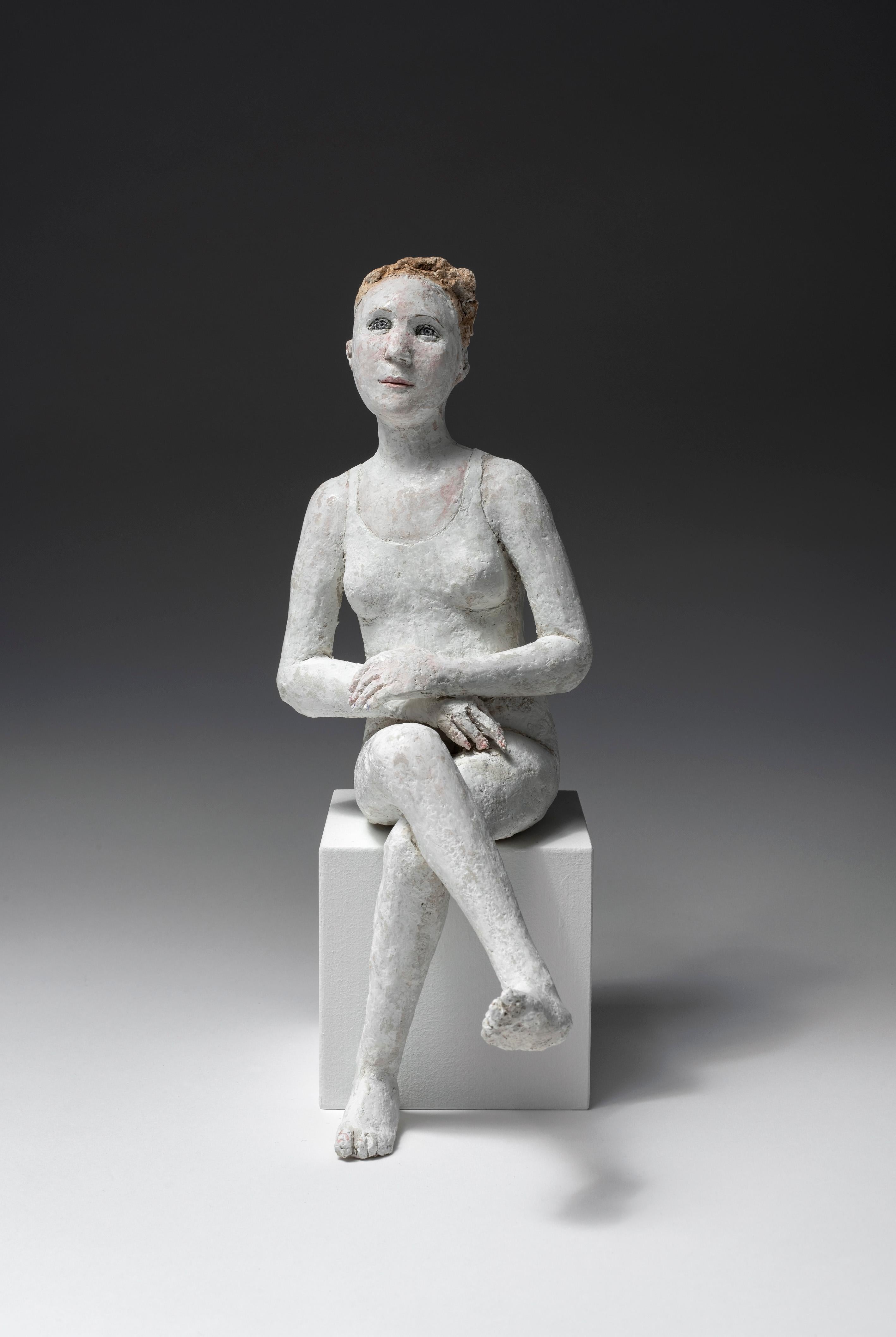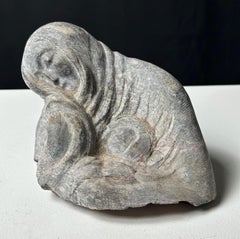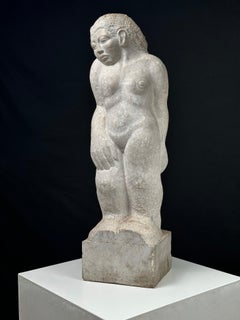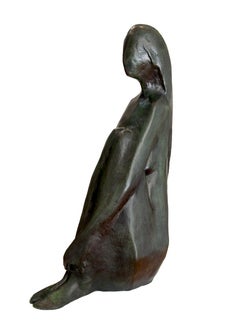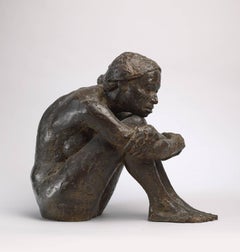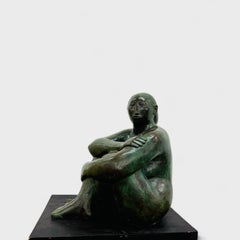Want more images or videos?
Request additional images or videos from the seller
1 of 10
Mark MorrisonSeated Womanca. 1940
ca. 1940
$3,500
$8,00056% Off
£2,653.53
£6,065.2156% Off
€3,065.39
€7,006.6256% Off
CA$4,955.36
CA$11,326.5356% Off
A$5,558.97
A$12,706.2256% Off
CHF 2,874.15
CHF 6,569.4956% Off
MX$67,044.27
MX$153,244.0456% Off
NOK� 36,565.25
NOK 83,577.7256% Off
SEK 34,246.83
SEK 78,278.4756% Off
DKK 22,878.19
DKK 52,29356% Off
About the Item
Mark Morrison (1895-1964)
Seated Woman, ca. 1950
Carved and polished red Italian marble
4.75" wide, 6 3/8" deep, height is 16.5""
Provenance: Estate of Mrs. Mark Morrison.
Born:
Kingfisher, OK
Education:
University of Missouri
John Flannagan, mentoring and private instruction ca. 1940
Art Students League with William Zorach and Jose de Creeft
Exhibited:
Sculpture Guild Annuals
Audubon Artists Annuals
National Academy of Design Annuals
Pennsylvania Academy Annuals
Metropolitan Museum Artists for Victory, 1942.
Newark Fine Arts Museum
Whitney Annuals
International Exhibition, Fairmount Park, Phila. 1950
Nebraska Fine Arts
Metropolitan Museum Exhibition, 1951
Boston Arts Festival
National Sculpture Society Annuals
Memberships:
Sculpture Guild, Inc.
Audubon Artists
Awards:
Ellen Prince Speyer Award, N.A. 1950
Architeects Leauge of New York, Avery Award, 1958, 1959.
Museum Collections:
Metropolitan Museum of Art
National Academy of Design
Pennsylvania Academy of Fine Arts
Whitney Museum of American Art.
Museum of Fine Arts, University of Arizona
Mark Morrison began his life as a sculptor while nearing his professional retirement. In the late 1930s and into the 1940s, he like many of the younger artists in New York City availed himself to the great many academies, museums, teachers and mentors it offered. He studied with John Flannagan before his death, and then Jose de Creeft and Williams Zorach at the Art Students League. Having an attraction and aptitude for the ideas of the direct carving movement and good thorough craft, he took advantage of the growing public interest in a new American sculpture, and worked quickly to become a contemporary of his teachers. Through the 1950s, he exhibited with them, sold, entered competitions, and won awards. He was a sculptor with a sure hand, a head for academy, patience, and promise. Morrison died suddenly in October 1964 having had just married his second wife earlier the same year. Mrs. Mark Morrison would offer a small piece for one more exhibition with a Sculptors Guild in 1965. The work was never seen again until 2025.
Morrison was born on New Year’s Day in 1895 in Kingfisher, Oklahoma, a small rural city not yet a part of the Union. The only child of a Protestant minister, and one of only 16 that in 1913 would graduate from his high school in Higginsville, Missouri. He studied agriculture at the University of Missouri, at some point leaving to enlist in the army. He would reach the rank of Major. After the war, he married his first wife, moved to New York and began work for Tidewater Oil. He worked with them until 1954, retiring as a vice president. At the time he was living at 8 W. 13th St., his studio already set up in a corner of the basement in his apartment building.
The earliest exhibition on record for a work by Morrison was the Artists for Victory show at the Metropolitan Museum, 1942. Earlier the same year, John Flanagan committed suicide. The death was a terrible blow. Flannagan had been a profound influence, sharing both technical instruction and philosophical guidance. The importance of their friendship during the 1930's cannot be overemphasized. Morrison is part of Flannagan's artistic legacy, his only known pupil during the mythical sculptor's short life. Born in the same year of 1895, both artists came to NYC from rural regions of the US: Oklahoma and North Dakota respectively. In contrast to Morrison's stable life, Flannagan was a deeply troubled, difficult, impatient and unpredictable man. To have considered mentoring Morrison, his teacher must have seen a kindred spirit and artist of extraordinary potential. In turn, Morrison must have been a sympathetic and patient pupil who recognized the importance of overlooking personal shortcomings for the invaluable instruction of an artistic genius.
Morrison did not show regularly for almost 10 years spending this time educating himself, exhibiting here and there. He continued his sculpture studies at the Art Student League with Zorach and de Creeft, spending most nights working stones in his studio. His mature style would become clearly realized by 1950, a synthesis of the naïve and the sophisticated, what Flanagan called "the image in the rock", and the polished fluid marbles of Zorach.
Black Swan was featured in the Sculptors Guild exhibition "In Time and Place" at the Museum of Natural History in March 1952. And exhibit pushing those points in their mission to assist the public to fuller appreciation of sculpture, and that the sculpture and the architecture of buildings may again be planned simultaneous and homogeneously. Morrison's swan was the centerpiece of the modern living room designed by Earnshaw, Inc. In the same hall of the museum one year earlier Morrison and other members of the group demonstrated process at work in seven makeshift studios. He would continue to exhibit in Guild annuals and Audubon Artist annuals. His sculpture "Gosling" was given a special honorable mention from the Architects League in the Avery Competition of 1958, runner up to Zorach. In 1959, when he showed "Grasshopper" he won outright.
He had moved his studio to a larger more private space a few blocks away in Greenwich Village. By 1964 his work had become larger in scale, his groupings more challenging and lively, more considerate of light and the nature of the stone itself. He had lost weight and for a man of nearly 70 years old was in very good health. His death was unexpected and unfortunate, probably of a stroke . His legacy has survived, largely unknown until now in a small ranch in upstate New York.
- Creator:Mark Morrison (1895 - 1964, American)
- Creation Year:ca. 1940
- Dimensions:Height: 16.5 in (41.91 cm)Width: 4.75 in (12.07 cm)Depth: 6.38 in (16.21 cm)
- Medium:
- Movement & Style:
- Period:
- Condition:
- Gallery Location:Wilton Manors, FL
- Reference Number:1stDibs: LU245216297962
About the Seller
4.9
Platinum Seller
Premium sellers with a 4.7+ rating and 24-hour response times
Established in 2007
1stDibs seller since 2015
416 sales on 1stDibs
Typical response time: 2 hours
- ShippingRetrieving quote...Shipping from: Reading, PA
- Return Policy
Authenticity Guarantee
In the unlikely event there’s an issue with an item’s authenticity, contact us within 1 year for a full refund. DetailsMoney-Back Guarantee
If your item is not as described, is damaged in transit, or does not arrive, contact us within 7 days for a full refund. Details24-Hour Cancellation
You have a 24-hour grace period in which to reconsider your purchase, with no questions asked.Vetted Professional Sellers
Our world-class sellers must adhere to strict standards for service and quality, maintaining the integrity of our listings.Price-Match Guarantee
If you find that a seller listed the same item for a lower price elsewhere, we’ll match it.Trusted Global Delivery
Our best-in-class carrier network provides specialized shipping options worldwide, including custom delivery.More From This Seller
View AllMadonna
Located in Wilton Manors, FL
Mark Morrison (1895-1964)
Madonna, ca. 1940
Carved stone
7" wide, 5" deep, height is 4.5"
Provenance: Estate of Mrs. Mark Morrison.
Born:
Kingfisher, OK
Education:
Univers...
Category
Mid-20th Century Realist Sculptures
Materials
Stone
$1,600 Sale Price
60% Off
Lilith (Female Nude)
Located in Wilton Manors, FL
Mark Morrison (1895-1964)
Lilith (Nude Figure) , ca. 1950
Carved stone
8.25" wide, 7.25" deep, height is 28.75"
Provenance: Estate of Mrs. Mark Morrison.
Born:
Kingfisher, OK...
Category
Mid-20th Century Cubist Sculptures
Materials
Granite
$5,000 Sale Price
50% Off
Monkey
Located in Wilton Manors, FL
Mark Morrison (1895-1964)
Monkey, ca. 1940
Carved New Hampshire granite
8.5" by 5", height is 16.5"
Provenance: Estate of Mrs. Mark Morrison.
Born:
Kingfisher, OK
Education:
...
Category
Mid-20th Century Realist Sculptures
Materials
Granite
$4,000 Sale Price
50% Off
Embryo Lizard
Located in Wilton Manors, FL
Mark Morrison (1895-1964)
Embryo, ca. 1940.
Carved Italian granite.
12.5" wide, 8.5" deep, height is 5"
Measurement are for stone form alone. It sits 12.5 inches tall at a pitch ...
Category
Mid-20th Century Realist Sculptures
Materials
Granite
$2,400 Sale Price
40% Off
Reclining Figure (woman)
By William King (b.1925)
Located in Wilton Manors, FL
William King (1925-2015). Reclining figure, ca. 1965. Cast and welded bronze, 7 x 9.5 x 5 inches. Unsigned.
William King, a sculptor in a variety of materials whose human figures traced social attitudes through the last half of the 20th century, often poking sly and poignant fun at human follies and foibles, died on March 4 at his home in East Hampton, N.Y. He was 90.
His death was confirmed by Scott Chaskey, who is married to Mr. King's stepdaughter, Megan Chaskey.
Mr. King worked in clay, wood, bronze, vinyl, burlap and aluminum. He worked both big and small, from busts and toylike figures to large public art pieces depicting familiar human poses -- a seated, cross-legged man reading; a Western couple (he in a cowboy hat, she in a long dress) holding hands; a tall man reaching down to tug along a recalcitrant little boy; a crowd of robotic-looking men walking in lock step.
But for all its variation, what unified his work was a wry observer's arched eyebrow, the pointed humor and witty rue of a fatalist. His figurative sculptures, often with long, spidery legs and an outlandishly skewed ratio of torso to appendages, use gestures and posture to suggest attitude and illustrate his own amusement with the unwieldiness of human physical equipment.
His subjects included tennis players and gymnasts, dancers and musicians, and he managed to show appreciation of their physical gifts and comic delight at their contortions and costumery. His suit-wearing businessmen often appeared haughty or pompous; his other men could seem timid or perplexed or awkward. Oddly, or perhaps tellingly, he tended to depict women more reverentially, though in his portrayals of couples the fragility and tender comedy inherent in couplehood settled equally on both partners.
Mr. King's work is in the collections of the Metropolitan Museum of Art and the Museum of Modern Art in New York and the Smithsonian American Art Museum in Washington, among other places, and he had dozens of solo gallery shows in New York and elsewhere. But the comic element of his work probably caused his reputation to suffer.
Reviews of his exhibitions frequently began with the caveat that even though the work was funny, it was also serious, displaying superior technical skills, imaginative vision and the bolstering weight of a range of influences, from the ancient Etruscans to American folk art to 20th-century artists including Giacometti, Calder. and Elie Nadelman.
The critic Hilton Kramer, one of Mr. King's most ardent advocates, wrote in a 1970 essay accompanying a New York gallery exhibit that he was, "among other things, an amusing artist, and nowadays this can, at times, be almost as much a liability as an asset."
A "preoccupation with gesture is the focus of King's sculptural imagination," Mr. Kramer wrote. "Everything that one admires in his work - the virtuoso carving, the deft handling of a wide variety of materials, the shrewd observation and resourceful invention - all this is secondary to the concentration on gesture. The physical stance of the human animal as it negotiates the social arena, the unconscious gait that the body assumes in making its way in the social medium, the emotion traced by the course of a limb, a torso, a head, the features of a face, a coiffure or a costume - from a keen observation of these materials King has garnered a large stock of sculptural images notable for their wit, empathy, simplicity and psychological precision."
William Dickey King...
Category
Mid-20th Century Abstract Abstract Sculptures
Materials
Bronze
$2,800 Sale Price
30% Off
Chipmunk
Located in Wilton Manors, FL
Mark Morrison (1895-1964)
Chipmunk, ca. 1940
Italian granite
5" by 4", height is 4 1/8"
Provenance: Estate of Mrs. Mark Morrison.
Born:
Kingfisher, OK
Education:
Universit...
Category
Mid-20th Century Realist Sculptures
Materials
Stone
You May Also Like
Sitting Lady
Located in Somerset West, WC
Sitting Lady is a limited edition bronze sculpture.
Created with the lost wax casting process.
Category
21st Century and Contemporary Nude Sculptures
Materials
Bronze
$18,070
Seated Figure
By Peter Brooke
Located in Pasadena, CA
Provenance
Acquired by the gallery directly from the artist
Exhibitions
Beauty and the Power of Sculpture, American Legacy Fine Arts, Octobe...
Category
Early 2000s Realist Nude Sculptures
Materials
Plaster
Sitting Woman
Located in Dallas, TX
Sitting Woman. Signed and Dated. 2/16, Bronze sculpture on wooden base
Jalisco, Mexico.
Category
21st Century and Contemporary More Art
Materials
Bronze
Rève (assise)
Located in Villafranca Di Verona, IT
Numbered and limited to 12 copies ( 8 + 4 P.A)
Artwork signed
Authenticity: Sold with certificate of Authenticity from the gallery
Invoice from the gallery
Sculpture: bronze, metal,...
Category
21st Century and Contemporary Modern Nude Sculptures
Materials
Bronze
Sitting Lady
Located in Somerset West, WC
Sitting Lady is a limited edition bronze sculpture.
Created with the lost wax casting process.
Category
21st Century and Contemporary Nude Sculptures
Materials
Bronze
Seated Female Figure: 'Nageuse Reveuse'
By Agnes Baillon
Located in New York, NY
‘I have created characters since I was a child.
I studied painting at the Ecole des Beaux Arts de Paris, but now I have a preference for sculpture.
I do not have an intellectual proc...
Category
2010s Contemporary Figurative Sculptures
Materials
Mixed Media
More Ways To Browse
Head Of A Woman Sculpture
A Vintage Vice
Marble Sculpture Woman
Fuller Vintage
Carved Stone Woman
Stone Head Sculpture Hand Carved
Stone Swan
John Swan
Marble Woman Head
Grasshopper Sculpture
Picasso Ceramic Femme
Antique Wayang Golek Puppets
Corneille Wood
Indonesian Golek Puppet
Kaws Small Lie
Luciano Zanoni
Naoshima Pumpkin
Scott Potter
